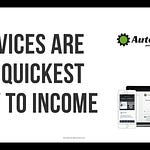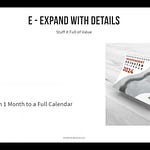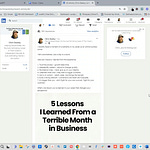There, you’ve worked hard to create a solid infrastructure for your business. You’ve set up a lead magnet, and people see your emails dripping in consistently, raising curiosity and turning followers into FANs. You are one step away from monetizing your SIMPLE Online Business.
You’re going to launch your first product or service. The goal is to further educate your customers on your topic—and to have them pay for it.
“But Chris, I gave away my best content on social media and by email. Why would anybody pay me for what they can get for free? Do I have to come up with something new?”
This mistake I’ve made many times. Convinced I had to Einstein out something I’d never shared, I racked my brains for some new value I could add.
I again overcomplicated things.
The trick is to educate your followers in a fresh format or structure. You organize your information so they don’t have to claw through six months of social posts to get the gold. You do the hard work of making it easier for them to consume.
As Russell Brunson, one of my digital mentors, says, “People will pay you to hear the same thing again in a different format.”
And it’s true.
Let’s cover the three major types of products to consider:
Books
Courses
Services
The list isn’t exhaustive, but these are the easiest products to start with.
Books
The idea for this book sprang from a conversation with a LinkedIn friend. I told him that, in the previous year, I’d gotten away with absolute simplicity. While reflecting on that talk, I concocted an acronym and posted it on LinkedIn. It didn’t go viral, but several people loved it and wanted to know more.
Instead of mouth-taping my wife and kids for silence so I could record a video series, I decided to write a book.
Why?
Because books bring clarity.
You’re hardly aware of how much your mind has figured out—the grooves in your brain can hide habits, workflows, and frames of reference. By sitting and flushing these things out into a book, you’ll force yourself to refine your ideas.
Writing a book can be difficult, but it doesn’t have to be. It depends on your goal and your message. Legacy publishing demands higher word counts than indie, and narrative nonfiction can be more of a puzzle to construct than some industry books. But I recommend you start simple.
You’re holding my twenty-fifth book. Over the years, I’ve found that writing mini books (around 10,000 words) can be quick and easy if you follow a simple process. I break this framework down in my previous book, Mini Book Model: How to Write Your Big Ideas in Small Books, but I’ll give you the quick and dirty version here.
Outlining
Once you have your idea—or, as I call it, framework—you take a legal pad or Word document and start outlining it. To simplify this process, I present three outlines anyone can use for any topic.
W's Method (Technically the 5W1H Method… but that is a mouthful)
Simply ask What, When, Where, Why, Who, and How about the topic and idea you’ve chosen to write about.
10 Problems
Write out the ten primary (customer) problems in your niche, industry, or topic. Address one problem in each chapter.
Sequential
This format is handy when describing a FRAMEwork (like this book); you write the process from start to finish.
Once you have chosen your structure and assigned your chapters, the rest of the outlining is simple.
3 Points per chapter
3 Subpoints per point
Here is my outline for the first chapter of this book.
Chapter 1: SELECT Your Expertise
Choose a customer
Who You Are
Who You Used to Be
Who You Love
Choose their problem
Bigger the better
Smaller is faster
First problem in series bonus
Find a solution
Talk with customers
Read communities
Try and Fail
This outline helped me stay focused, and I always knew what to write next.
Writing
With your outline, you’ve made your writing process super easy—just fill in the blanks and connect the dots.
I usually start with a 1-3-1 format. This is: one opening sentence, a three-sentence paragraph filling in the details, and one concluding sentence. For each subpoint in my chapter, I use at least two 1-3-1s.
Notice that the sentence you’re reading completes a 1-3-1 cycle.
The 1-3-1 method ensures enough explanation without risking any rambling. Once your message is tight and clear, you can ditch this strict format if doing so improves logic or flow. But starting with this format makes writing easier and less overwhelming.
I learned about the 1-3-1 method from Nicolas Cole and Dickie Bush from Ship30for30, a writing cohort.
Distributing
You did it! You turned your framework into an excellent read. Now, how do you get your book under the right eyeballs?
I could write a whole stack of books on this subject, but I’ll give you a few options and my opinion.
You can:
Deliver it yourself (like a lead magnet)
Publish it to Amazon (Kindle Direct Publishing/KDP)
Publish it on other digital book platforms
Publish it on your own digital store
Each of these has pros and cons, but here is my opinion.
If you want to:
Start quick – Use the Gumroad platform to sell and deliver it yourself
Build authority – Publish to Amazon
Make the most $$$ – Do everything
I write books for my clarity and to find readers. Selling my books on Amazon helps me find customers and build authority. Books aren’t likely to make you rich, but they can be potent compost to fertilize the soil of your business.
It isn’t about revenue; it’s about the respect authors enjoy over course creators. With your book on leading platforms, you can become a respected voice in your niche—seemingly overnight.
For more help writing a book, check out my Mini Book Model on Amazon.














Share this post